A
Auto Express
Guest
As a package the MG ZS EV has genuine appeal – especially as a second car, a company car or an affordable route into a pure electric vehicle. This can only be good news for MG as it continues to push for growth in the UK.
Irrespective of its high-voltage powertrain, the ZS sits towards the more practical side of the small SUV market, offering more space than many of the alternatives.
Electric rivals claim to have considerably longer ranges, but next to the likes of Nissan’s Leaf (the entry-level model) and Renault’s Zoe, MG’s electric SUV measures up rather well. If buyers can get past having a badge that isn’t the most desirable, it makes a lot of sense.
It is no secret that SUVs and crossovers have seen massive sales growth in the UK in recent years. This means that, irrespective of whether electrons, petrol or diesel is being used to power a vehicle down the road, there are no shortage of rivals for a small SUV like the MG ZS.
Things are slightly less crowded for battery-powered SUVs, especially more affordable options such as the MG ZS EV we’re looking at here, but even this sub-sector is filling up fast.
Manufacturing costs remain high for electric vehicles so few makers are able to offer prices anywhere near those of petrol or diesel equivalents. Despite this, MG has managed to deliver a pure electric SUV at a very attractive price which is ultimately its main weapon in attracting buyers. So it is that the MG ZS EV has to compete with more expensive rivals such as the Peugeot e-2008, Kia Soul EV, Hyundai Kona Electric and Mazda MX-30 - with more on the way.
The MG ZS has had a relatively short life so far, as an SUV that is. MG previously sold a ZS saloon and family hatchback based on the Rover 45 up until 2005 when the remaining assets of MG Rover moved into Chinese ownership. When the ZS was reborn in 2017 it returned as a petrol SUV that showed how the new MG brand was making strides in upping the quality of its cars. Even so, the ZS remained a budget option let down by relatively poor fuel economy. The MG ZS EV addressed this by swapping the petrol motor for a pure electric powertrain.

MG ZS EV
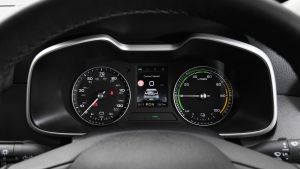
MG ZS EV
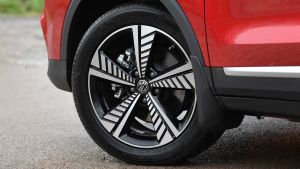
MG ZS EV
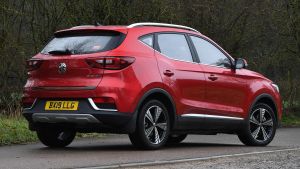
MG ZS EV
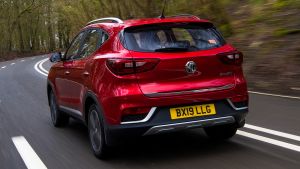
MG ZS EV
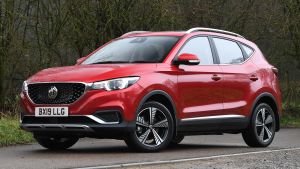
MG ZS EV
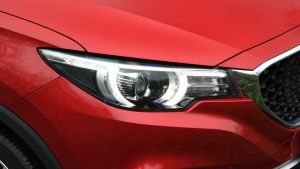
MG ZS EV
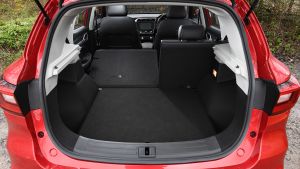
MG ZS EV

MG ZS EV
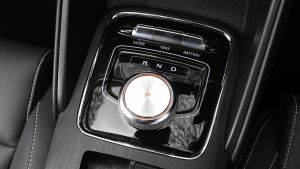
MG ZS EV
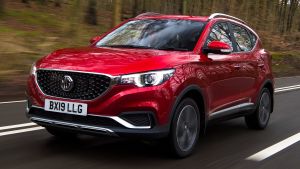
MG ZS EV - front driving
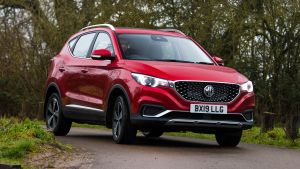
MG ZS EV
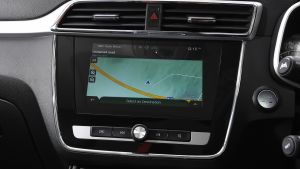
MG ZS EV
MG offers two trims for ZS EV owners to choose from, Excite and Exclusive and both are well equipped for their respective list prices. The number of body styles is pretty straightforward too, as there is just one available – a practical five-door SUV. Similarly, all battery-powered ZS EVs come with the same battery, electric motor and gearbox.
Flashy badge or not, the growing demand for small EVs means the ZS EV could be ideally positioned to be one of MG’s best selling cars – in the UK at least. Part of this potential is thanks to MG’s manufacturing capability. While rivals from Hyundai or Kia have long waiting lists, MG looks to have the capacity to increase production. This is helped by the fact that it recently opened a battery factory in China which is claimed to be able to produce enough cells for up to 300,000 vehicles a year.
The ZS isn’t a hero in the fun handling department, but for some this won’t matter one jot. Like many electric cars, the ZS EV is brilliantly easy to drive. Turn it on, select drive with the simple rotary controller, press the accelerator pedal and you’re away. The driving mode selector is equally straightforward and helps drivers prioritise between efficiency or performance.
Driving in town is incredibly easy and thanks to the immediate availability of torque, nipping away from traffic lights and out of junctions isn’t stressful at all. Furthermore, there is a toggle switch in the centre console that is used to adjust the amount of regenerative braking applied when a driver lifts off the throttle. There are four settings that range from no regeneration to one that MG claims offers “near one-pedal driving” by slowing the car quickly when the accelerator is released. With a bit of practice, drivers will find that MG isn’t far off the mark with that claim.

MG ZS EV

MG ZS EV

MG ZS EV

MG ZS EV

MG ZS EV

MG ZS EV

MG ZS EV

MG ZS EV

MG ZS EV

MG ZS EV

MG ZS EV - front driving

MG ZS EV

MG ZS EV
In addition to this, motor whine is kept nicely at bay and the steering is light, if lacking in feel. MG’s engineers have geared the suspension of the ZS EV more towards comfort and so it protects occupants from road imperfections vibrating into the cabin. This comfort does come at the expense of body control, with the ZS pitching and rolling more than some of the alternatives.
All models come with a single electric motor powering the front wheels that produces 141bhp and 353Nm of torque. The result is a 0-62mph time of 8.5 seconds that puts the MG on par with Peugeot’s e-2008 but slightly behind the Kia Soul EV and Hyundai Kona Electric. Top speed is 87mph and while this initially seems modest, it is still significantly more than is legal to do on any UK road.
Instead of a miles per gallon rating, the MG ZS EV comes with a miles per kiloWatt-hour figure (commonly shortened to miles/kWh) which gives an indication of an electric car’s efficiency. MG claims a combined figure of 3.3 miles/kWh under WLTP testing. This puts it behind direct rivals such as the Kia e-Niro.
Naturally, having no exhaust sticking out of the rear bumper means there are zero tailpipe emissions from the ZS EV. For the ultimate low emission motoring, drivers need to use electricity generated through renewable means (such as wind or solar) to charge their car.
As for running costs, the MG ZS’ should be very low thanks to the relative simplicity of an electric motor compared to petrol or diesel engines and regenerative braking helping to reduce the wear and tear on brake rotors and brake discs. There is also MG’s long warranty – but more on that later.
For company car drivers, the MG ZS EV qualifies for the lowest possible Benefit-in-Kind (BiK) company car tax. The 2021/22 tax year will see BiK rise to 1 per cent (up from zero in 2020/21) before going to 2 per cent in 2022/23. For someone in the 20 per cent income tax bracket, this will mean payments of about £5 per month for Excite models. A higher earner will pay near £10 per month, but compared to a petrol or diesel model these represent a fraction of the cost.
Being electric the ZS EV avoids any tax when first registered and any subsequent payments. For reference, an entry-level Ford Focus would cost £175 in year one and £150 thereafter.
Electric range can make or break an electric car and the MG ZS EV is claimed to have a maximum range of 163 miles under WLTP testing. It is worth noting that this is on a combined cycle – for city driving, where regenerative braking is more frequent that figure is pushed up to 231 miles.
A range of 163 miles is a match for the entry-level Nissan Leaf and more than quoted ranges for smaller EVs, such as the Honda e and the Mini Electric. The main reason for the ZS being unable to travel as far on a single charge as some rivals (such as the Hyundai Kona Electric) is due to the battery pack size. While the MG makes do with a 44.5kWh unit, the Kona comes with a pack well in excess of 60kWhs - but this is a key reason why the MG is cheaper to buy.

MG ZS EV

MG ZS EV

MG ZS EV

MG ZS EV

MG ZS EV

MG ZS EV

MG ZS EV

MG ZS EV

MG ZS EV

MG ZS EV

MG ZS EV - front driving

MG ZS EV

MG ZS EV
When it comes to charge times the ZS can support up to 50kW power supplies, well above what your typical household wall box will produce. Assuming a 50kW charger is being used, a ZS will go from empty to 80% in 40 minutes. Using a typical 7kW domestic wall box should mean a full charge takes six and a half hours. The charging port itself is located behind the MG badge on the front grille and is a CCS/Type 2 port.
Irrespective of trim an electric ZS sits in insurance group 21A. This means it sits in a lower group than many of its rivals with higher range – including the Hyundai Kona Electric – but on a par with Nissan’s Leaf. As a result, the ZS EV should fare pretty well when it comes to insurance premiums and the lower list price should also help here.
Modern-day MGs haven’t been known for leading the field in terms of residual values. That said, they tend to be very affordable in the first place, so should have less of a distance to fall. Experts predict that electric ZS models will retain just above 40% of their value after three years and 36,000 miles – meaning they will be worth around £11,000 to £12,000 depending on spec.
It is worth considering that the shifting demand towards electric cars and long waiting lists in some cases may well help the MG retain value. At the same time, longer-range models becoming more affordable will likely work against the ZS. While MG is not one of the most desirable car brands, it is on the up in the UK with more and more motorists seeing the benefits behind what is a more affordable badge.
Aesthetically the MG ZS is so-so. It is far from ugly, but it is just a bit generic to our eyes. It is clear that there are influences from other Asian cars, in particular a whiff of Mazda CX-3 from some angles. This isn’t just levelled at the electric ZS as petrol models look largely identical. The chrome-highlighted grille unique to the ZS EV does help give it some individuality, though, and the smart alloy wheels help as well.

MG ZS EV

MG ZS EV

MG ZS EV

MG ZS EV

MG ZS EV

MG ZS EV

MG ZS EV

MG ZS EV

MG ZS EV

MG ZS EV

MG ZS EV - front driving

MG ZS EV

MG ZS EV
At heart, the ZS is quite a boxy SUV, which helps with cabin space. Even so, MG’s designers have done well to somewhat mask the angular proportions through use of a tapered roofline and angled rear side windows. There are four colours to choose from; Pimlico Blue, Arctic White, Black Pearl and Dynamic Red.
The ZS is based on a platform specifically designed for MG’s SUVs – it is not all that cutting edge but it serves its purpose well enough. On the other hand, equipment is plentiful. Entry-level (for the electric models) Excite versions get 17-inch alloy wheels, air-conditioning, cruise control, keyless entry, rear parking sensors, LED daytime running lights, DAB radio and Apple CarPlay/Android Auto compatibility.
Moving up to range-topping Exclusive trim costs an additional £2,500 but in return adds an opening panoramic glass roof, heated front seats, roof rails, automatic wipers, a rear parking camera and some extra speakers.
Regardless of the long list of equipment, it is the cabin that exposes the ZS’ budget-roots. Things are not horrendous, but small things such as the fact the steering wheel only adjusts for rake and not reach and the rock-hard plastic door linings do detract from the experience.
The infotainment system’s graphics are crisp enough, even if the screen is housed behind a secondary sheet of glass which is all too happy to catch reflections. While the system is logical enough to use (and responds well to touch) the menus require a little getting used to before they become second nature. USB and Bluetooth connectivity are both available.
Thanks to its boxy shape, the ZS EV is quite practical despite its compact dimensions and is ideally suited to those with kids, dogs or both. There is no seven-seat option, although few fully-electric cars can offer this, even in the classes above. There is plenty of space for five (especially compared to something like a Renault Zoe) and lots of a driver’s seat adjustment. That said, you do seem to sit a little too high, making it feel more like you are sitting on the ZS rather than in it.

MG ZS EV

MG ZS EV

MG ZS EV

MG ZS EV

MG ZS EV

MG ZS EV

MG ZS EV

MG ZS EV

MG ZS EV

MG ZS EV

MG ZS EV - front driving

MG ZS EV

MG ZS EV
The seats are comfortable enough that long journeys shouldn’t be a pain, plus the large door pockets and extra cubby holes allow for plenty of storage for snacks, maps and books. During a long journey, the rear middle seat might start to feel a bit tight if larger humans are either side. As for visibility, things from the driver’s perspective are good.
The MG ZS EV is 4,314mm long and 2,048mm wide (including wing mirrors but 1,809mm excluding them). Height depends on trim, Excite models are 1,620mm tall and Exclusive are 1,644mm – the difference is due to the latter coming with roof rails. This puts the ZS EV almost on par with a Qashqai – the Nissan being slightly longer and wider but shorter.
All four of the main seats offer good head and legroom but the middle rear seat is on the narrow side. Even so, the tunnel down the centre of the car’s floor doesn’t encroach too much into the cabin so there are good amounts of legroom for a middle passenger.

MG ZS EV

MG ZS EV

MG ZS EV

MG ZS EV

MG ZS EV

MG ZS EV

MG ZS EV

MG ZS EV

MG ZS EV

MG ZS EV

MG ZS EV - front driving

MG ZS EV

MG ZS EV
MG has managed to make sure that adding a big battery hasn’t translated to a tiny boot. With all seats in place there is 470 litres available and with the rears down you get 1,100 litres. Kia’s e-Niro offers roughly the same capacities but Nissan’s Leaf isn’t quite as practical.
The boot is a good shape in addition to being a decent size (which helps when loading awkward objects) and the dual height floor means there is the flexibility of having maximum cargo space or a flat load bay
MG used its electrified ZS to usher in some new active safety technology not seen before from the brand. Excite models come as standard with front collision warning, lane departure warning, adaptive cruise control (with automatic stop and go) and traffic jam assist with braking, steering and accelerating within a lane. Exclusive models go even further, with blind-spot detection and rear cross-traffic alert – the latter helpful when reversing out of a parking space.
While the MG ZS EV hasn’t specifically appeared in our Driver Power ownership results, the petrol ZS has. It ranked 55th out of 75 cars, which puts it ahead of the Hyundai Kona (60th) but behind the original Renault Zoe (37th) and second-generation Nissan Leaf (24th).
As a brand, MG finished 20th out of 30 marques, which despite being some way off Kia (2nd) and Nissan (11th) it was ahead of Audi (21st), BMW (27th) and Mercedes (28th).
Crash test experts Euro NCAP awarded the ZS EV a full five stars out of five in 2019. Rating it at 90% for adult occupant protection, 85% for child occupant protection, 70% for safety assist and 64% for vulnerable road users.

MG ZS EV

MG ZS EV

MG ZS EV

MG ZS EV

MG ZS EV

MG ZS EV

MG ZS EV

MG ZS EV

MG ZS EV

MG ZS EV

MG ZS EV - front driving

MG ZS EV

MG ZS EV
All new MGs come with an impressive warranty – seven years or 80,000 miles, whichever comes first. This is the same for the battery pack. While as a core warranty this is strong, the battery cover is ever so slightly behind some manufacturers which protect their batteries for eight years or 100,000 miles.
MG reckons it will cost half as much to service a ZS EV compared to a petrol model. Unfortunately, the Chinese brand is yet to confirm how often the electric ZS needs servicing. On a plus side, though, all MG dealerships are claimed to be set up to be able to work on ZS EVs with charging points and trained technicians on site.
Continue reading...
Irrespective of its high-voltage powertrain, the ZS sits towards the more practical side of the small SUV market, offering more space than many of the alternatives.
Electric rivals claim to have considerably longer ranges, but next to the likes of Nissan’s Leaf (the entry-level model) and Renault’s Zoe, MG’s electric SUV measures up rather well. If buyers can get past having a badge that isn’t the most desirable, it makes a lot of sense.
About the MG ZS EV
It is no secret that SUVs and crossovers have seen massive sales growth in the UK in recent years. This means that, irrespective of whether electrons, petrol or diesel is being used to power a vehicle down the road, there are no shortage of rivals for a small SUV like the MG ZS.
Things are slightly less crowded for battery-powered SUVs, especially more affordable options such as the MG ZS EV we’re looking at here, but even this sub-sector is filling up fast.
- SEE MORE Best electric cars to buy 2021
Manufacturing costs remain high for electric vehicles so few makers are able to offer prices anywhere near those of petrol or diesel equivalents. Despite this, MG has managed to deliver a pure electric SUV at a very attractive price which is ultimately its main weapon in attracting buyers. So it is that the MG ZS EV has to compete with more expensive rivals such as the Peugeot e-2008, Kia Soul EV, Hyundai Kona Electric and Mazda MX-30 - with more on the way.
The MG ZS has had a relatively short life so far, as an SUV that is. MG previously sold a ZS saloon and family hatchback based on the Rover 45 up until 2005 when the remaining assets of MG Rover moved into Chinese ownership. When the ZS was reborn in 2017 it returned as a petrol SUV that showed how the new MG brand was making strides in upping the quality of its cars. Even so, the ZS remained a budget option let down by relatively poor fuel economy. The MG ZS EV addressed this by swapping the petrol motor for a pure electric powertrain.

MG ZS EV

MG ZS EV

MG ZS EV

MG ZS EV

MG ZS EV

MG ZS EV

MG ZS EV

MG ZS EV

MG ZS EV

MG ZS EV

MG ZS EV - front driving

MG ZS EV

MG ZS EV
MG offers two trims for ZS EV owners to choose from, Excite and Exclusive and both are well equipped for their respective list prices. The number of body styles is pretty straightforward too, as there is just one available – a practical five-door SUV. Similarly, all battery-powered ZS EVs come with the same battery, electric motor and gearbox.
Flashy badge or not, the growing demand for small EVs means the ZS EV could be ideally positioned to be one of MG’s best selling cars – in the UK at least. Part of this potential is thanks to MG’s manufacturing capability. While rivals from Hyundai or Kia have long waiting lists, MG looks to have the capacity to increase production. This is helped by the fact that it recently opened a battery factory in China which is claimed to be able to produce enough cells for up to 300,000 vehicles a year.
The ZS isn’t a hero in the fun handling department, but for some this won’t matter one jot. Like many electric cars, the ZS EV is brilliantly easy to drive. Turn it on, select drive with the simple rotary controller, press the accelerator pedal and you’re away. The driving mode selector is equally straightforward and helps drivers prioritise between efficiency or performance.
Driving in town is incredibly easy and thanks to the immediate availability of torque, nipping away from traffic lights and out of junctions isn’t stressful at all. Furthermore, there is a toggle switch in the centre console that is used to adjust the amount of regenerative braking applied when a driver lifts off the throttle. There are four settings that range from no regeneration to one that MG claims offers “near one-pedal driving” by slowing the car quickly when the accelerator is released. With a bit of practice, drivers will find that MG isn’t far off the mark with that claim.

MG ZS EV

MG ZS EV

MG ZS EV

MG ZS EV

MG ZS EV

MG ZS EV

MG ZS EV

MG ZS EV

MG ZS EV

MG ZS EV

MG ZS EV - front driving

MG ZS EV

MG ZS EV
In addition to this, motor whine is kept nicely at bay and the steering is light, if lacking in feel. MG’s engineers have geared the suspension of the ZS EV more towards comfort and so it protects occupants from road imperfections vibrating into the cabin. This comfort does come at the expense of body control, with the ZS pitching and rolling more than some of the alternatives.
Engines, 0-60 acceleration and top speed
All models come with a single electric motor powering the front wheels that produces 141bhp and 353Nm of torque. The result is a 0-62mph time of 8.5 seconds that puts the MG on par with Peugeot’s e-2008 but slightly behind the Kia Soul EV and Hyundai Kona Electric. Top speed is 87mph and while this initially seems modest, it is still significantly more than is legal to do on any UK road.
Instead of a miles per gallon rating, the MG ZS EV comes with a miles per kiloWatt-hour figure (commonly shortened to miles/kWh) which gives an indication of an electric car’s efficiency. MG claims a combined figure of 3.3 miles/kWh under WLTP testing. This puts it behind direct rivals such as the Kia e-Niro.
Naturally, having no exhaust sticking out of the rear bumper means there are zero tailpipe emissions from the ZS EV. For the ultimate low emission motoring, drivers need to use electricity generated through renewable means (such as wind or solar) to charge their car.
- SEE MORE Cheapest hybrid cars 2021
As for running costs, the MG ZS’ should be very low thanks to the relative simplicity of an electric motor compared to petrol or diesel engines and regenerative braking helping to reduce the wear and tear on brake rotors and brake discs. There is also MG’s long warranty – but more on that later.
For company car drivers, the MG ZS EV qualifies for the lowest possible Benefit-in-Kind (BiK) company car tax. The 2021/22 tax year will see BiK rise to 1 per cent (up from zero in 2020/21) before going to 2 per cent in 2022/23. For someone in the 20 per cent income tax bracket, this will mean payments of about £5 per month for Excite models. A higher earner will pay near £10 per month, but compared to a petrol or diesel model these represent a fraction of the cost.
Being electric the ZS EV avoids any tax when first registered and any subsequent payments. For reference, an entry-level Ford Focus would cost £175 in year one and £150 thereafter.
Electric range, battery life and charge time
Electric range can make or break an electric car and the MG ZS EV is claimed to have a maximum range of 163 miles under WLTP testing. It is worth noting that this is on a combined cycle – for city driving, where regenerative braking is more frequent that figure is pushed up to 231 miles.
A range of 163 miles is a match for the entry-level Nissan Leaf and more than quoted ranges for smaller EVs, such as the Honda e and the Mini Electric. The main reason for the ZS being unable to travel as far on a single charge as some rivals (such as the Hyundai Kona Electric) is due to the battery pack size. While the MG makes do with a 44.5kWh unit, the Kona comes with a pack well in excess of 60kWhs - but this is a key reason why the MG is cheaper to buy.

MG ZS EV

MG ZS EV

MG ZS EV

MG ZS EV

MG ZS EV

MG ZS EV

MG ZS EV

MG ZS EV

MG ZS EV

MG ZS EV

MG ZS EV - front driving

MG ZS EV

MG ZS EV
When it comes to charge times the ZS can support up to 50kW power supplies, well above what your typical household wall box will produce. Assuming a 50kW charger is being used, a ZS will go from empty to 80% in 40 minutes. Using a typical 7kW domestic wall box should mean a full charge takes six and a half hours. The charging port itself is located behind the MG badge on the front grille and is a CCS/Type 2 port.
Insurance groups
Irrespective of trim an electric ZS sits in insurance group 21A. This means it sits in a lower group than many of its rivals with higher range – including the Hyundai Kona Electric – but on a par with Nissan’s Leaf. As a result, the ZS EV should fare pretty well when it comes to insurance premiums and the lower list price should also help here.
Depreciation
Modern-day MGs haven’t been known for leading the field in terms of residual values. That said, they tend to be very affordable in the first place, so should have less of a distance to fall. Experts predict that electric ZS models will retain just above 40% of their value after three years and 36,000 miles – meaning they will be worth around £11,000 to £12,000 depending on spec.
It is worth considering that the shifting demand towards electric cars and long waiting lists in some cases may well help the MG retain value. At the same time, longer-range models becoming more affordable will likely work against the ZS. While MG is not one of the most desirable car brands, it is on the up in the UK with more and more motorists seeing the benefits behind what is a more affordable badge.
Aesthetically the MG ZS is so-so. It is far from ugly, but it is just a bit generic to our eyes. It is clear that there are influences from other Asian cars, in particular a whiff of Mazda CX-3 from some angles. This isn’t just levelled at the electric ZS as petrol models look largely identical. The chrome-highlighted grille unique to the ZS EV does help give it some individuality, though, and the smart alloy wheels help as well.

MG ZS EV

MG ZS EV

MG ZS EV

MG ZS EV

MG ZS EV

MG ZS EV

MG ZS EV

MG ZS EV

MG ZS EV

MG ZS EV

MG ZS EV - front driving

MG ZS EV

MG ZS EV
At heart, the ZS is quite a boxy SUV, which helps with cabin space. Even so, MG’s designers have done well to somewhat mask the angular proportions through use of a tapered roofline and angled rear side windows. There are four colours to choose from; Pimlico Blue, Arctic White, Black Pearl and Dynamic Red.
The ZS is based on a platform specifically designed for MG’s SUVs – it is not all that cutting edge but it serves its purpose well enough. On the other hand, equipment is plentiful. Entry-level (for the electric models) Excite versions get 17-inch alloy wheels, air-conditioning, cruise control, keyless entry, rear parking sensors, LED daytime running lights, DAB radio and Apple CarPlay/Android Auto compatibility.
Moving up to range-topping Exclusive trim costs an additional £2,500 but in return adds an opening panoramic glass roof, heated front seats, roof rails, automatic wipers, a rear parking camera and some extra speakers.
Regardless of the long list of equipment, it is the cabin that exposes the ZS’ budget-roots. Things are not horrendous, but small things such as the fact the steering wheel only adjusts for rake and not reach and the rock-hard plastic door linings do detract from the experience.
Sat-nav, stereo and infotainment
The infotainment system’s graphics are crisp enough, even if the screen is housed behind a secondary sheet of glass which is all too happy to catch reflections. While the system is logical enough to use (and responds well to touch) the menus require a little getting used to before they become second nature. USB and Bluetooth connectivity are both available.
Thanks to its boxy shape, the ZS EV is quite practical despite its compact dimensions and is ideally suited to those with kids, dogs or both. There is no seven-seat option, although few fully-electric cars can offer this, even in the classes above. There is plenty of space for five (especially compared to something like a Renault Zoe) and lots of a driver’s seat adjustment. That said, you do seem to sit a little too high, making it feel more like you are sitting on the ZS rather than in it.

MG ZS EV

MG ZS EV

MG ZS EV

MG ZS EV

MG ZS EV

MG ZS EV

MG ZS EV

MG ZS EV

MG ZS EV

MG ZS EV

MG ZS EV - front driving

MG ZS EV

MG ZS EV
The seats are comfortable enough that long journeys shouldn’t be a pain, plus the large door pockets and extra cubby holes allow for plenty of storage for snacks, maps and books. During a long journey, the rear middle seat might start to feel a bit tight if larger humans are either side. As for visibility, things from the driver’s perspective are good.
Size
The MG ZS EV is 4,314mm long and 2,048mm wide (including wing mirrors but 1,809mm excluding them). Height depends on trim, Excite models are 1,620mm tall and Exclusive are 1,644mm – the difference is due to the latter coming with roof rails. This puts the ZS EV almost on par with a Qashqai – the Nissan being slightly longer and wider but shorter.
Legroom, headroom & passenger space
All four of the main seats offer good head and legroom but the middle rear seat is on the narrow side. Even so, the tunnel down the centre of the car’s floor doesn’t encroach too much into the cabin so there are good amounts of legroom for a middle passenger.

MG ZS EV

MG ZS EV

MG ZS EV

MG ZS EV

MG ZS EV

MG ZS EV

MG ZS EV

MG ZS EV

MG ZS EV

MG ZS EV

MG ZS EV - front driving

MG ZS EV

MG ZS EV
Boot
MG has managed to make sure that adding a big battery hasn’t translated to a tiny boot. With all seats in place there is 470 litres available and with the rears down you get 1,100 litres. Kia’s e-Niro offers roughly the same capacities but Nissan’s Leaf isn’t quite as practical.
- SEE MORE Best used electric cars 2021
The boot is a good shape in addition to being a decent size (which helps when loading awkward objects) and the dual height floor means there is the flexibility of having maximum cargo space or a flat load bay
MG used its electrified ZS to usher in some new active safety technology not seen before from the brand. Excite models come as standard with front collision warning, lane departure warning, adaptive cruise control (with automatic stop and go) and traffic jam assist with braking, steering and accelerating within a lane. Exclusive models go even further, with blind-spot detection and rear cross-traffic alert – the latter helpful when reversing out of a parking space.
While the MG ZS EV hasn’t specifically appeared in our Driver Power ownership results, the petrol ZS has. It ranked 55th out of 75 cars, which puts it ahead of the Hyundai Kona (60th) but behind the original Renault Zoe (37th) and second-generation Nissan Leaf (24th).
As a brand, MG finished 20th out of 30 marques, which despite being some way off Kia (2nd) and Nissan (11th) it was ahead of Audi (21st), BMW (27th) and Mercedes (28th).
Crash test experts Euro NCAP awarded the ZS EV a full five stars out of five in 2019. Rating it at 90% for adult occupant protection, 85% for child occupant protection, 70% for safety assist and 64% for vulnerable road users.

MG ZS EV

MG ZS EV

MG ZS EV

MG ZS EV

MG ZS EV

MG ZS EV

MG ZS EV

MG ZS EV

MG ZS EV

MG ZS EV

MG ZS EV - front driving

MG ZS EV

MG ZS EV
Warranty
All new MGs come with an impressive warranty – seven years or 80,000 miles, whichever comes first. This is the same for the battery pack. While as a core warranty this is strong, the battery cover is ever so slightly behind some manufacturers which protect their batteries for eight years or 100,000 miles.
Servicing
MG reckons it will cost half as much to service a ZS EV compared to a petrol model. Unfortunately, the Chinese brand is yet to confirm how often the electric ZS needs servicing. On a plus side, though, all MG dealerships are claimed to be set up to be able to work on ZS EVs with charging points and trained technicians on site.
Continue reading...
